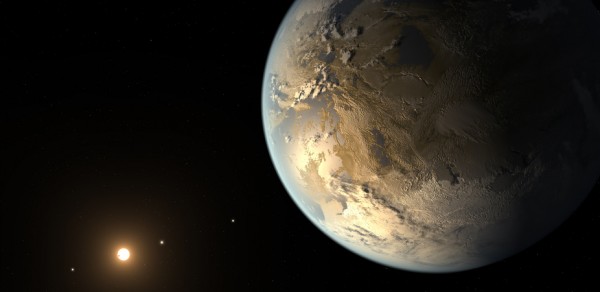The number of confirmed planets orbiting stars other than the Sun in our galaxy is rapidly growing. The unusual configurations and locations of these so-called “exoplanets” amaze and challenge our understanding of the universe. However the big motivation is to locate exoplanets that could potentially sustain life.
The habitable zone, or “Goldilocks zone”, around a star is the area within an orbital range of distance that allows for the right temperature to support liquid water – something we consider crucial for life as we know it. Now a joint team from the Australian National University and Niels Bohr Institute in Copenhagen suggest that we may have an even better chance of company than we previously thought. In research published in Monthly Notices of the Royal Astronomical Society, calculations suggest that the billions of stars in our galaxy may have between one and three exoplanets in their habitable zones.
It’s an exciting find. Looking at our own Solar System of eight planets we know the odds of life are low and that life in the galaxy may be rather lonely. We have Venus, Earth and Mars in or near the habitable zone around the Sun. But only the Earth was able to maintain its water. In the case of Mars the thin atmosphere allowed the planet to cool so the once flowing water is now locked up in perma-frost. In Venus’ case the water remains as vapour due to the extremely high surface temperature resulting from the thick carbon dioxide atmosphere. There has also been the suggestion in recent years that tectonic activity and a tilted axis of rotation axis results in seasons that are needed for life to evolve.

T. Pyle, CC BY
An 18th-century law
The team base their new calculations on the assumption that the large number of already confirmed exoplanets in apparent isolation are actually part of larger planetary systems. This is a strong possibility given that high mass and short orbital periods mean exoplanets are much easier to detect than other types of planet. They then theorise the presence of these other exoplanets using the Titus-Bode law, famous for correctly calculating the position of the planet Uranus.
The Titus-Bode Law was formulated around 1770 and states the ratio between the orbital periods of planets in a star system. For example, the ratio between the time for Mercury and Venus to travel around the Sun equals the ratio in time between Venus and Earth. Any gaps in the sequence may suggest an as yet undetected planet in the system.
The researchers applied this law to 151 planetary systems in which the Kepler satellite (a dedicated transiting exoplanet survey mission) has found between three and six exoplanets. They found the law fit easily with the known exoplanets in 124 of the systems, which allowed the prediction of further exoplanets. In the remaining 27 systems the law could be applied if as-yet-undetected exoplanets were assumed to exist both in-between and beyond those already detected.
Conservative calculations
Of course this technique has the potential to predict exoplanets in ever longer orbital periods. So the group took a conservative path and “only made calculations for planets where there is a good chance that you can see them with the Kepler satellite,” according to Steffen Kjær Jacobsen, from the astrophysics and planetary science research group at the Niels Bohr Institute at the University of Copenhagen. This led to the prediction of between one and three exoplanets in the habitable zone for each of the 151 planetary systems studied.
Based on their statistics, Jacobsen then suggests that “a good share of the planets in the habitable zone will be solid planets where there might be liquid water and where life could exist”.
The team are now encouraging other researchers to follow up on a sub-set of 77 predicted exoplanets in 40 planetary systems within the Kepler data in order to test their theory. This subset of predicted exoplanets was chosen on the basis of their likelihood of transiting across the face of their host star from the perspective of an Earth-based observer.
Of course it is understood by the scientific community that life can exist in many forms and need not even be carbon based, as we are. But we have confirmation that carbon-based life forms which rely on water can exist – or your wouldn’t be reading this article. So the search begins with an attempt to find a second example of what we know exists before exploring other options.
![]()
This article was originally published on The Conversation.
Read the original article.



